Outdoor STEAM Education Training Certification
Coursework and Practicum
Teaching outdoors offers a long-term and lasting impact to the educational system, students served, and Santa Clara Valley environment and the preservation of local ecology. It also boosts children’s immune systems by providing opportunities for them to play in natural, healthy soils with native plant biodiversity.
STEAM = Science & Technology, interpreted through Engineering & the Arts, all based in Mathematical elements
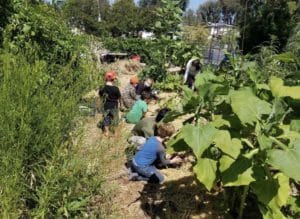 Participants who earn this certificate will be prepared to design, build, and maintain an outdoor teaching garden, and will work with other teachers to learn how to convert conventional STEAM lessons to lessons appropriate for an outdoor classroom. Outdoor classrooms can be used for any curriculum, but are especially advantageous for teaching science, technology, the arts, and math; our program will therefore focus especially on STEAM curriculum. Participants will learn to think ecologically, to share their knowledge with their own students, and to be ambassadors for outdoor learning and ecological education in their communities.
Participants who earn this certificate will be prepared to design, build, and maintain an outdoor teaching garden, and will work with other teachers to learn how to convert conventional STEAM lessons to lessons appropriate for an outdoor classroom. Outdoor classrooms can be used for any curriculum, but are especially advantageous for teaching science, technology, the arts, and math; our program will therefore focus especially on STEAM curriculum. Participants will learn to think ecologically, to share their knowledge with their own students, and to be ambassadors for outdoor learning and ecological education in their communities.
Teachers will learn the 26 physical and pedagogical components of an ELSEE (The Environmental Lab for Sustainability and Ecological Education)- and USGBC-certified outdoor classroom; they will learn to build, maintain, and teach 50 “Playing with Intent: Nature Immersion + Food” lesson plans in an ELSEE-certified outdoor classroom, and will learn how to attract community volunteers and funding to help create and maintain their teaching garden. Teachers who complete the certification will have the skills to design, create, maintain, and teach in an ELSEE-certified outdoor classroom.
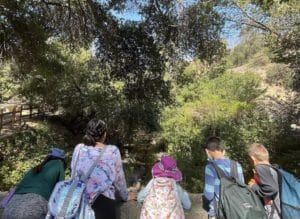 1) Students will learn elements of California Ecology, including a range of our local ecosystems (including grasslands, coastal, desert, chaparral, mixed evergreen forest, and redwood) which are showcased in our flagship ELSEE garden. By showcasing our local ecology, each ELSEE garden teaches children how to love, restore and protect our natural environment.
1) Students will learn elements of California Ecology, including a range of our local ecosystems (including grasslands, coastal, desert, chaparral, mixed evergreen forest, and redwood) which are showcased in our flagship ELSEE garden. By showcasing our local ecology, each ELSEE garden teaches children how to love, restore and protect our natural environment.
2) Students will learn how to use Regenerative Organic Agriculture methods to teach children how to grow their own food in an ELSEE garden, and how to restore soil with compost, no-till agriculture, and native plants.
3) Students will learn how to design, create, and maintain an ELSEE-certified teaching garden. Students will learn 26 components of ELSEE-certified gardens.
Depending on the site, each teaching garden will include ecological elements, such as:
- insectary plants
- local native plant communities
- sustainable methods of irrigation
- reuse, cleansing and storage of rainfall and large storm events
- different kinds of soils
- aquaponics
- re-use of materials(renew, reuse and repurpose)
- ROA (regenerative organic agriculture) mounds
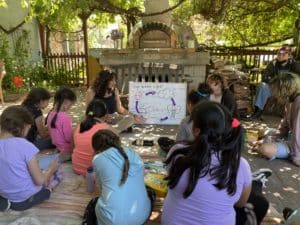 Pedagogical elements include:
Pedagogical elements include:
- indigenous edibles
familiar comfort foods - a children’s herb garden including herbs especially good for children, such as lemonbalm, mint, lavender, chamomile, yerba buena, and cultural herbs, based on the demographics of the school
- pollinator and insectary plants distributed through plant communities
- paths where children can run around, and ROA food mounds where they know to look for food
- secret and wild areas for observation and study
- areas where children can climb, hide, and make-believe, made of natural and/or reused materials (such as climbing trees, stump hops, log balance beans, sand pits, and water-play areas
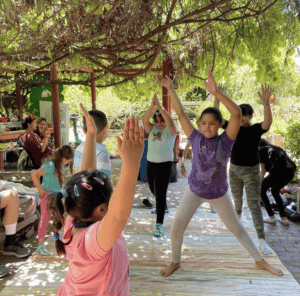 maker areas with protection from the sun (including tables, scrap wood, age-appropriate tools, supplies for painting and crafts, kept in secure, waterproof area); found objects (such as old boats,cars, trailers, etc) for climbing and pretend play. Toxic paints, etc, must be removed.
maker areas with protection from the sun (including tables, scrap wood, age-appropriate tools, supplies for painting and crafts, kept in secure, waterproof area); found objects (such as old boats,cars, trailers, etc) for climbing and pretend play. Toxic paints, etc, must be removed.- Edibles at height where children can tend to them. Dangerous (poisonous or prickly) plants must be clearly labeled, and in a special area, or avoided, depending on population.
- Fences built of reused pallets or other repurposed materials
- Areas for water play and washing and preparing food
- Areas where children can play in the mud or sand
- Rope bridges
- Shaded areas with seating for projects or storytelling, performances
- Vertical gardens (food towers, or aquaponics garden, living roofs, tool shed, found objects that are repurposed.
- Community events: “barn raising,” workshops, food distribution
- A “stage” for dancing, storytelling, and performance
- Play kitchen area (made with real cooking tools)
- Greenhouse and propagating area
- Greywater system
- Rainwater storage tanks
- Original art
- Plastic-free zone
4) Students will learn how to grow, harvest, and prepare native and sustainable food plants, and will learn how to provide complete nutrition with locally grown foods. Students will learn how to share this knowledge with their classrooms, integrate food harvesting and preparation into their curriculum, and introduce new and appealing recipes to children and their families.
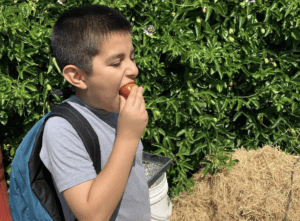 5) Students will learn a variety of Native American stories, how and why to tell them, and the relationship of indigenous storytelling to native species of plants and animals.
5) Students will learn a variety of Native American stories, how and why to tell them, and the relationship of indigenous storytelling to native species of plants and animals.
6) Students will study the history, theory, and practice of outdoor education. They will study issues of inclusion and safety in outdoor education; the health benefits to learning and playing outdoors, and how we can shift our educational paradigms towards outdoor learning for all ages.
7) Participants will learn how to introduce gardening to their students; specific methods for instilling curiosity and confidence about how we grow our own food using ROA methods, and how to share our love of nature, biological diversity, and how to be better stewards of our planet.
8) Students will learn how to convert conventional STEAM lessons for use in the outdoor classroom, and will collaborate to create an online resource with an array of outdoor lessons that can be shared by all participants.
9) Students will learn how to raise funds through grants and community organizations, and volunteer labor to help create and sustain their teaching gardens.
9) Our lesson plans inventory consists of over 50 STEAM 6-12 years education plans that were developed in certified ELSEE teaching gardens. This also includes 35 Earth Hero’s Nature Badges that can be earned by students, while fulfilling STEAM requirements. These lessons can be demonstrated and practiced by students and included in final projects.
Course Descriptions
Course One: Introduction to California Ecology
This class will introduce students to the main ecosystems of our region. Students will learn about native plant and animal communities, with a focus on ecosystems of our region. This will provide California educators with a foundation for understanding and teaching about the complex systems that sustain the natural world around us. Some field trips required.
Course Two: Eating California: Introduction to Regional Plant-based Cuisine
Students will learn how to grow, harvest, cook, and design family-friendly, appealing menus based on native and sustainable food plants. We will introduce CNGF’s 21st Century Food Pyramid, which demonstrates ways to provide complete nutrition using foods we can grow locally, with regenerative agriculture.
Course Three: Indigenous Storytelling and Native California Species: Theory and Practice
Students will read a variety of essays about the relation of indigenous storytelling to our local ecosystem, based on the reciprocal relationship of indigenous peoples to the land. We will have opportunities to hear and tell stories, both new and traditional, both with and without props. We will discuss sensitivity to cultural differences, particularly when telling stories from traditions and cultures that are not our own, and discuss how to properly tell and attribute traditional stories, even as storytellers, in some way, makes each story their own.
Selections from:
Kimmerer, R. W. (2013). Braiding Sweetgrass: Indigenous Wisdom, Scientific Knowledge and the Teachings of Plants. Minneapolis, MN: Milkweed Editions.
Course Four: From Compost to Harvest: Teaching Regenerative Gardening Methods to Children
Student-teachers will learn how to grow and maintain a teaching garden with children, focusing on a variety of native plants and their relationships to animals, other plants, and the ecosystem. We will focus on how to use hands-on activities to instill, in children, tools for how to grow their own food, a love of nature, and an understanding how to be better stewards of our planet.
Course Five: STEAM Education in the Outdoor Classroom
This course will teach how to transform lessons in nearly any topic to take advantage of the outdoor classroom, with a special emphasis on science, math, and art. We will review the history of outdoor education in different countries, and learn best practices for creating outdoor, project-based curriculum that meets CORE standards, but infuses learning with excitement and meaning. As a final project, students will transform one of the best lessons from their own classrooms to work in an ELSEE teaching garden. Final projects will be collected in an online shared resource folder for use by all participants. Participants will also have access to Earth Heroes Nature Badge Program, a STEAM education program designed to teach elementary and middle school students in an ELSEE teaching garden.
“Compact nature: The role of playing and learning gardens on children’s lives.”
RC Moore. Journal of Therapeutic Horticulture, 1996 – JSTOR.
(Phil Noteware)
Earth’s Hero Nature Badge Program
Course Six: Introduction to Designing, Growing and Maintaining ELSEE (Environmental Laboratory for Sustainability and Ecological Education) Teaching Gardens
Students will learn how to propagate, grow, and harvest native food plants in an urban, regenerative garden. They will have opportunities to compare and design a variety of native gardens. They will learn which plants attract beneficial insects, which plants should be planted together, and also learn when plants are best propagated and harvested. They will be introduced to sustainable irrigation, aquaponics, different kinds of soil, and the theory and practice of regenerative organic methods of agriculture and gardening in our urban landscape.
Course Seven: Field Study Practicum in Outdoor STEAM Education
Teachers will design an ELSEE-model teaching garden for use at their school. Teachers will revise traditional assignments for an outdoor classroom, implement these assignments with students, and evaluate their results. Final projects will be collected in a collaborative resource folder for other teachers to use and be inspired by.

